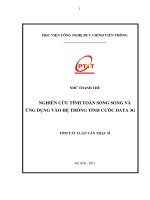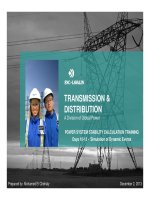Phần 6 KHÓA ĐÀO TẠO TÍNH TOÁN ỔN ĐỊNH VÀ ỨNG DỤNG TRÊN PHẦN MỀM PSSE CHO KỸ SƯ HỆ THỐNG ĐIỆN (Lý thuyết về quá trình Ổn định quá độ)
Bạn đang xem bản rút gọn của tài liệu. Xem và tải ngay bản đầy đủ của tài liệu tại đây (7.36 MB, 40 trang )
TRANSMISSION &
DISTRIBUTION
A Division of Global Power
POWER SYSTEM STABILITY CALCULATION TRAINING
D2
T i t St bilit
D
ay
2
-
T
rans
i
en
t
St
a
bilit
y
July5,2013
Prepared by: Peter Anderson
eBook for You
OUTLINE
2
OUTLINE
• The Swing Equation
• Application to Synchronous Machines
• Step-by-Step Solution Method
eBook for You
THE SWING EQUATION
3
THE
SWING
EQUATION
Power-Angle Relationship
d
2
θ = dω = ω0.(Pm – Pe)
dt
2
dt
2H
dt
2
dt
2H
H = Inertia Constant = J.ω
2
/2S in MW-s/MVA or
seconds
Metric: GD
2
in kg-m
2
6
22
10.kVA
)RPM(×)GD(×48163.5
=H
Imperial: WR
2
in lb.ft
2
6
22
10.kVA
)RPM(×)WR(×231.0
=H
eBook for You
ANALYSIS OF THE SWING EQUATION
4
ANALYSIS
OF
THE
SWING
EQUATION
dω = ω0.(Pm – Pe)
dt
2H
dt
2H
In terms of short
-
term transient stability studies
In
terms
of
short
-
term
transient
stability
studies
,
P
m
is constant
m
Rotor acceleration is a function of the Electrical
Power
eBook for You
APPLICATION TO SYNCHRONOUS
5
MACHINES
Increase in Mechanical Power Input
Pm increased
Rotor accelerates from 25
deg. to new operating point
at 40 de
g
.
1.2
1.4
g
Rotor overshoots to 60 deg,
where area above Pm equals
the area below Pm
Now
Pe
>
Pm and rotor
0.8
1
Now
Pe
Pm
and
rotor
decelerates towards θ=40
deg.
Rotor will oscillate around
θ
=
40 deg.
0.2
0.4
0.6
θ
40
deg.
If the overshoot reaches
θ=140 deg. The rotor will not
be able to return to the new
operating point and will slip
0
0 10 20 30 40 50 60 70 80 90 100 110 120 130 140 150 160 170 180
operating
point
and
will
slip
to the next pole position
eBook for You
STEP
BY
STEP SOLUTION METHOD
6
STEP
-
BY
-
STEP
SOLUTION
METHOD
Pm Increased
(1 ) (2) (3 ) (4 ) (5 ) (6 ) (7 ) (8 ) (9 ) (1 0) (1 1) (12)
T θ Pm Pe Pa Ac c eleration ∆t1 ∆ω ω ∆t2 ∆θ θ
(3)‐(4) (5)*k (6 )*(7) deg/s (9 )*(10) (2)+(11)
‐0.0 θ0 Pm0 Pe0 Pm0‐Pe0 0 ‐ 0 ω0=0 ‐
+0.0 θ0 Pm1 Pe0 Pm1‐Pe0 α0 ∆t/2 ∆ω1 ω0+∆ω1=ω1 ∆t ∆θ1 θ1
0.5 θ1 Pm1 Pe1 Pm1‐Pe1 α1 ∆t ∆ω2 ω1+∆ω2=ω2 ∆t ∆θ2 θ2
1 θ2 Pm1 Pe2 Pm1‐Pe2 α2 ∆t ∆ω3 ω2+∆ω3=ω3 ∆t ∆θ3 θ3
1.5 θ3 Pm1 Pe3 Pm1‐Pe3 α3 ∆t ∆ω4 ω3+∆ω4=ω4 ∆t ∆θ4 θ4
2 θ4 Pm1 Pe4 Pm1‐Pe4 α4 ∆t ∆ω5 ω4+∆ω5=ω5 ∆t ∆θ5 θ5
08
1
1.2
1.4
0.2
0.4
0.6
0
.
8
0
0 10 20 30 40 50 60 70 80 90 100 110 120 130 140 150 160 17 0 180
eBook for You
STEP
BY
STEP SOLUTION METHOD
7
STEP
-
BY
-
STEP
SOLUTION
METHOD
Pm Increased from 0.42 to 0.8 pu
1.00
1.20
0.60
0.80
0.20
0.40
0.00
0 30 60 90 120 150 180
eBook for You
STEP
BY
STEP SOLUTION METHOD
8
STEP
-
BY
-
STEP
SOLUTION
METHOD
T θ Pm Pe Pa α∆t1 ∆ω ω ∆t2 ∆θ θ
00
25 0
042
042
0
0
0
0
00
‐
0
.
0
25
.
0
0
.
42
0
.
42
0
0
0
0
0
.
0
0 2 5.0 0.80 0.4 2 0.38 10.87 0.25 2.72 2.7 0.5 1.4 26.4
0.5 26.4 0.80 0.44 0.36 10.25 0.5 5.13 7.8 0 .5 3.9 30.3
1 30.3 0.80 0.50 0.30 8.52 0.5 4.26 12.1 0. 5 6.1 36.3
1.5 36.3 0.80 0.59 0.21 5.98 0.5 2.99 15.1 0.5 7.5 43.9
2 43.9 0.80 0.69 0.11 3.08 0.5 1.54 16.6 0. 5 8.3 52.2
2.5 52.2 0.80 0.79 0.01 0.29 0.5 0.14 16.8 0.5 8.4 60.6
360.60.800.87‐0.07 ‐2.05 0.5 ‐1.02 15.8 0 .5 7.9 68.5
3.5 68.5 0.80 0.93 ‐0.13 ‐3.75 0.5 ‐1.87 13.9 0 .5 6.9 75.4
475.40.800.97‐0.17 ‐4.83 0.5 ‐2.41 11.5 0 .5 5.7 81.1
4.5 81.1 0.80 0.99 ‐0.19 ‐5.42 0.5 ‐2.71 8.8 0.5 4.4 85.5
585.50.801.00‐0.20 ‐5.67 0.5 ‐2.84 5.9 0.5 3.0 88.5
5.5 88.5 0.80 1.00 ‐0.20 ‐5.75 0.5 ‐2.87 3.0 0.5 1.5 90.0
690.00.801.00‐0.20 ‐5.76 0.5 ‐2.88 0.2 0.5 0.1 90.1
6.5 90.1 0.80 1.00 ‐0.20 ‐5.76 0.5 ‐2.88 ‐2.7 0.5 ‐1.4 88.7
788.70.801.00‐0.20 ‐5.75 0.5 ‐2.88 ‐5.6 0.5 ‐2.8 85.9
75
85 9
080
100
020
569
05
284
84
05
42
81 7
7
.
5
85
.
9
0
.
80
1
.
00
‐
0
.
20
‐
5
.
69
0
.
5
‐
2
.
84
‐
8
.
4
0
.
5
‐
4
.
2
81
.
7
881.70.800.99‐0.19 ‐5.46 0.5 ‐2.73 ‐11.2 0.5 ‐5.6 76.1
8.5 76.1 0.80 0.97 ‐0.17 ‐4.92 0.5 ‐2.46 ‐13.6 0.5 ‐6.8 69.3
969.30.800.94‐0.14 ‐3.90 0.5 ‐1.95 ‐15.6 0.5 ‐7.8 61.5
9.5 61.5 0.80 0.88 ‐0.08 ‐2.27 0.5 ‐1.14 ‐16.7 0.5 ‐8.4 53.2
10 53.2 0.80 0.80 0.00 ‐0.01 0.5 0.00 ‐16.7 0.5 ‐8.4 44.8
eBook for You
STEP
BY
STEP SOLUTION METHOD
9
STEP
-
BY
-
STEP
SOLUTION
METHOD
Pm Increased from 0.42 to 0.8 pu
80 0
90.0
100.0
50.0
60.0
70.0
80
.
0
Angle(deg)
10 0
20.0
30.0
40.0
Machine
0.0
10
.
0
0 2.5 5 7.5 10 12.5 15
Time(s)
eBook for You
TRANSMISSION &
DISTRIBUTION
A Division of Global Power
POWER SYSTEM STABILITY CALCULATION TRAINING
D3
T i t St bilit
D
ay
3
-
T
rans
i
en
t
St
a
bilit
y
July8,2013
Prepared by: Peter Anderson
eBook for You
CASE STUDY: ANALYSIS OF A FAULT CASE
2
CASE
STUDY:
ANALYSIS
OF
A
FAULT
CASE
L1
L2
3
h f lt li L2 l t t b
3
-p
h
ase
f
au
lt
on
li
ne
L2
, c
l
ose
t
o genera
t
or
b
us
Frequency = 60 Hz
Inertia Constant = 3.0 s
P
fltP AlC i
θ
/0 8
P
re-
f
au
lt
P
ower
A
ng
l
e
C
urve = s
i
n
θ
/0
.
8
Post-fault Power Angle Curve = sinθ/1.1
Fault duration = 0.1 s
Time Step = 0.02 s
eBook for You
CASE STUDY: ANALYSIS OF A FAULT CASE
3
CASE
STUDY:
ANALYSIS
OF
A
FAULT
CASE
Ste
p
1: Construct Power-
A
n
g
le Curves
p
g
1.40
1.00
1.20
040
0.60
0.80
0.00
0.20
0
.
40
0 30 6 0 90 1 20 150 180
eBook for You
CASE STUDY: ANALYSIS OF A FAULT CASE
4
CASE
STUDY:
ANALYSIS
OF
A
FAULT
CASE
Step 1: Construct Step-by-Step Table
K 3600 =180*f
/(
H* S
)
/( )
1 2 34 5 6 7 8 9 101112
Pa α∆t1 ∆ω ω ∆t2 ∆θ θ
(3 )‐(4) (5)*K (6)*(7) (9)
N‐1
+(8)
N
(9 )*(10 ) (2)+(11 )
s deg pu pu pu deg/s/s s deg/s deg/s s deg deg
‐
0.0
39.8
0.80
0.80
T θ Pm Pe
0.0
39.8
0.80
0.80
0 39.8 0.80 0.00 0.80 2880 0.01 28.80 28.8 0.02 0.6 40.4
0.02 40.4 0.80 0.00 0.80 2880 0.02 57.60 86.4 0.02 1.7 42.1
0.04 42.1 0.80 0.00 0.80 2880 0.02 57.60 144.0 0.02 2.9 45.0
0.06 45.0 0.80 0.00 0.80 2880 0.02 57.60 201.6 0.02 4.0 49.0
0.08
49.0
0.80
0.00
0.80
2880
0.02
57.60
259.2
0.02
5.2
54.2
0.08
49.0
0.80
0.00
0.80
2880
0.02
57.60
259.2
0.02
5.2
54.2
0.1 54.2 0.80 0.00 0.80 2880 0.01 28.80 288.0
0.1 54.2 0.80 0.76 0.04 152 0.01 1.52 289.5 0.02 5.79 60.0
0.12 60.0 0.80 0.81 ‐0.01 ‐52 0.02 ‐1.04 200.6 0.02 4.0 64.0
0.14 64.0 0.80 0.85 ‐0.05 ‐179 0.02 ‐3.58 197.0 0.02 3.9 67.9
0.16
67.9
0.80
0.88
‐
0.08
‐
291
0.02
‐
5.83
191.2
0.02
3.8
71.8
0.16
67.9
0.80
0.88
0.08
291
0.02
5.83
191.2
0.02
3.8
71.8
0.18 71.8 0.80 0.91 ‐0.11 ‐389 0.02 ‐7.78 183.4 0.02 3.7 75.4
0.2 75.4 0.80 0.93 ‐0.13 ‐471 0.02 ‐9.42 174.0 0.02 3.5 78.9
0.22 78.9 0.80 0.95 ‐0.15 ‐539 0.02 ‐10.77 163.2 0.02 3.26 82.2
0.24 82.2 0.80 0.96 ‐0.16 ‐592 0.02 ‐11.85 151.3 0.02 3.03 85.2
0.26
85.2
0.80
0.98
‐
0.18
‐
634
0.02
‐
12.68
138.7
0.02
2.77
88.0
0.26
85.2
0.80
0.98
0.18
634
0.02
12.68
138.7
0.02
2.77
88.0
0.28 88.0 0.80 0.98 ‐0.18 ‐665 0.02 ‐13.30 125.4 0.02 2.51 90.5
0.3 90.5 0.80 0.99 ‐0.19 ‐687 0.02 ‐13.74 111.6 0.02 2.23 92.7
eBook for You
CASE STUDY: ANALYSIS OF A FAULT CASE
5
CASE
STUDY:
ANALYSIS
OF
A
FAULT
CASE
Step 1: Plot Results
100.0
120.0
60.0
80.0
h
ineAngle (deg)
20.0
40.0
Mac
h
0.0
0 0.1 0.2 0.3 0.4 0.5 0.6
Time(s)
eBook for You
THREE PHASE SHORT
CIRCUIT
6
THREE
PHASE
SHORT
-
CIRCUIT
Steady-state:
Leakage Reactance of the machine (X
)
Leakage
Reactance
of
the
machine
(X
l
)
Armature Reaction to the Fault Current (X
a
)
S
y
nchronous Reactance X
d
= X
l
+
X
a
y
d
l
a
X
l
X
a
E
eBook for You
THREE PHASE SHORT
CIRCUIT
7
THREE
PHASE
SHORT
-
CIRCUIT
At the instant of the Fault:
Leakage Reactance of the machine (X
l
)
Armature Reaction to the Fault Current (X
a
)
Since the Air Gap flux cannot change instantaneously,
currents are induced in the field and damper windings (X
dw
and
X
f
)
f
)
Sub-transient Reactance X
d
= X
l
+ 1/(1/X
a
+1/X
dw
+ 1/X
f
)
X
l
X
a
X
dw
E
X
f
eBook for You
THREE PHASE SHORT
CIRCUIT
8
THREE
PHASE
SHORT
-
CIRCUIT
Shortly after the instant of the Fault:
Leakage Reactance of the machine (X
l
)
Leakage
Reactance
of
the
machine
(X
l
)
Armature Reaction to the Fault Current (X
a
)
Damper winding currents (low X/R ratio) die out
q
uickl
y
qy
Transient Reactance X
d
= X
l
+ 1/(1/X
a
+ 1/X
f
)
E
X
l
X
a
E
X
f
eBook for You
THREE PHASE SHORT
CIRCUIT
9
THREE
PHASE
SHORT
-
CIRCUIT
6
2
4
(pu)
Sub‐transie n
t
‐
4
‐2
0
Current
Transient
Sync hronous
‐6
4
0 0.05 0.1 0.15 0.2 0.25 0.3
Time(s)
eBook for You
SYNCHRONOUS MACHINE MODELS
10
SYNCHRONOUS
MACHINE
MODELS
Single Phase Equivalent of a 3-phase Generator
jXd I
EU
~
Im
E
jXd I
jXd
.
I
δ Re
θ U
I
I
eBook for You
SYNCHRONOUS MACHINE MODELS
11
SYNCHRONOUS
MACHINE
MODELS
Three Possible Generator Models:
Synchronous Model (Constant voltage behind Xd)
Synchronous
Model
(Constant
voltage
behind
Xd)
Transient Model (Constant voltage behind Xd’)
Sub-transient Model (Constant/Variable voltage
behind Xd”
)
)
•Sub-transient model allows exciter effects to be explicitly
represented
For each model, the prime mover can be
represented as a fixed power model or a variable
p
ower model under the control of
g
overnor
pg
action
eBook for You
MODEL APPLICATION
12
MODEL
APPLICATION
Use of Mixed Generator Models:
Complex models used for machines of interest
Simpler models used for remote machines
•
Requires less data
•
Requires
less
data
•Significantly reduces the computing burden
With the removal of computer limitations, it
is recommended to use the sub-transient
model for all generators
eBook for You
TRANSMISSION &
DISTRIBUTION
A Division of Global Power
POWER SYSTEM STABILITY CALCULATION TRAINING
D4
T i t St bilit
D
ay
4
-
T
rans
i
en
t
St
a
bilit
y
July9,2013
Prepared by: Peter Anderson
eBook for You
OUTLINE
2
OUTLINE
• Machine Differential Equations
• Exciter Differential Equations
GDifftilEti
•
G
overnor
Diff
eren
ti
a
l
E
qua
ti
ons
• Solution of Differential Equations
• Network Solution
• Sample Cases
eBook for You
BASIC MODELS IN STABILITY STUDIES
3
BASIC
MODELS
IN
STABILITY
STUDIES
Synchronous Machines
Swing Equations:
Swing
Equations:
()
aem
0
p.D‐P‐P.
H
ω
=ωp ∂
0
ω‐ω=p
H
∂
Flux Linkage Differential Equations:
(
)
[
]
(
)
[
]
'
d
q
'
q
q
'
d
"
d
q
"
q
q
"
d
E
‐
I
X
‐
X
1
=
pE
E
‐
I
X
‐
X
1
=
pE
(
)
[
]
(
)
[
]
(
)
[
]
(
)
[
]
'
q
d
'
d
d
fd
'
'
q
"
q
d
"
d
'
d
'
q
"
"
q
d
q
q
q
'
0q
d
d
q
q
q
"
0q
d
E‐IX‐X‐E
1
=
p
EE‐IX‐X‐E
1
=
p
E
E
I
X
X
T
pE
E
I
X
X
T
pE
(
)
[
]
(
)
[
]
q
d
d
d
fd
'
0d
q
q
d
d
d
q
"
0d
q
T
p
T
p
eBook for You
BASIC MODELS IN STABILITY STUDIES
4
BASIC
MODELS
IN
STABILITY
STUDIES
Synchronous Machines
Algebraic Model:
Algebraic
Model:
V
‐
E
.
Y
=
I
I
.
X‐
R
=
V‐E
d
q
a
dd
(
)
FrameferenceReSystemtoFrameferenceReMachinefromtionTransforma
V
E
.
Y
I
I
.
RXV‐E
qadqq
(
)
()()
∂‐2/πj‐expI+I=jI+I
qdMR
I
Y
Y. E
Y.V
V
eBook for You









